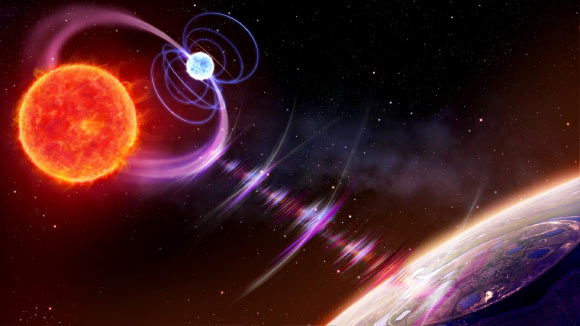Astrophysicists have found that a recently-discovered transient radio source, ILT J110160.52+552119.62, whose roughly minute-long pulses arrive with a periodicity of 125.5 min, is an red dwarf-white dwarf binary system with an orbital period that matches the period of the radio pulses, which are observed when the two stars are in conjunction.
In recent years, astronomers have detected radio pulses from sources in the Milky Way that last from seconds to minutes.
These pulses are unlike anything expected from known pulsars, which produce pulses on the order of milliseconds.
Furthermore, unlike radio pulsars, these so-called long-period transients (LPTs) are periodic at timescales of tens of minutes to hours.
There have been a few hypotheses for the origins of these novel pulses, but evidence has been scant.
“There are several highly magnetized neutron stars, or magnetars, that are known to exhibit radio pulses with a period of a few seconds,” said Northwestern astrophysicist Charles Kilpatrick.
“Some astrophysicists also have argued that sources might emit pulses at regular time intervals because they are spinning, so we only see the radio emission when source is rotated toward us.”
“Now, we know at least some long-period radio transients come from binaries.”
“We hope this motivates radio astronomers to localize new classes of sources that might arise from neutron star or magnetar binaries.”
In their study, Dr. Kilpatrick and colleagues focused on periodic radio signals from a transient radio source designated ILT J110160.52+552119.62 (ILT J1101+5521).
Using a novel imaging technique, they detected several of these radio pulses in the data collected by the Low Frequency Array (LOFAR).
Acting like a large radio camera, the telescope could pinpoint the exact location of the radio source in the sky.
According to the team, the object is about 1,600 light-years away in the constellation of Ursa Major.
Follow-up observations with the 6.5-m diameter…
Read the full article here

